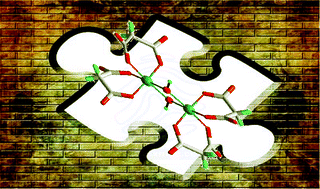Building-block process for the synthesis of new chromium(iii) malonate complexes†
Abstract
We describe the crystal structures of two bimetallic compounds with the

* Corresponding authors
a
Laboratorio de Rayos X y Materiales Moleculares, Departamento de Física Fundamental II, Facultad de Física, Universidad de La Laguna, Avda. Astrofísico Francisco Sánchez s/n, La Laguna, Tenerife, Spain
E-mail:
caruiz@ull.es
b Departamento de Química Inorgánica, Facultad de Química, Universidad de La Laguna, Avda. Astrofísico Francisco Sánchez s/n, La Laguna, Tenerife, Spain
c Laboratorio de Rayos X y Materiales Moleculares, Departamento de Física Básica, Facultad de Física, Universidad de La Laguna, Avda. Astrofísico Francisco Sánchez s/n, La Laguna, Spain
d Instituto de Ciencia Molecular (ICMol)/Departament de Química Inorgànica, Universitat de València, Polígono La Coma s/n, Paterna, València, Spain
We describe the crystal structures of two bimetallic compounds with the

 Please wait while we load your content...
Something went wrong. Try again?
Please wait while we load your content...
Something went wrong. Try again?
F. S. Delgado, J. Sanchiz, T. López, F. Lloret, M. Julve and C. Ruiz-Pérez, CrystEngComm, 2010, 12, 2711 DOI: 10.1039/B920650G
To request permission to reproduce material from this article, please go to the Copyright Clearance Center request page.
If you are an author contributing to an RSC publication, you do not need to request permission provided correct acknowledgement is given.
If you are the author of this article, you do not need to request permission to reproduce figures and diagrams provided correct acknowledgement is given. If you want to reproduce the whole article in a third-party publication (excluding your thesis/dissertation for which permission is not required) please go to the Copyright Clearance Center request page.
Read more about how to correctly acknowledge RSC content.
 Fetching data from CrossRef.
Fetching data from CrossRef.
This may take some time to load.
Loading related content
